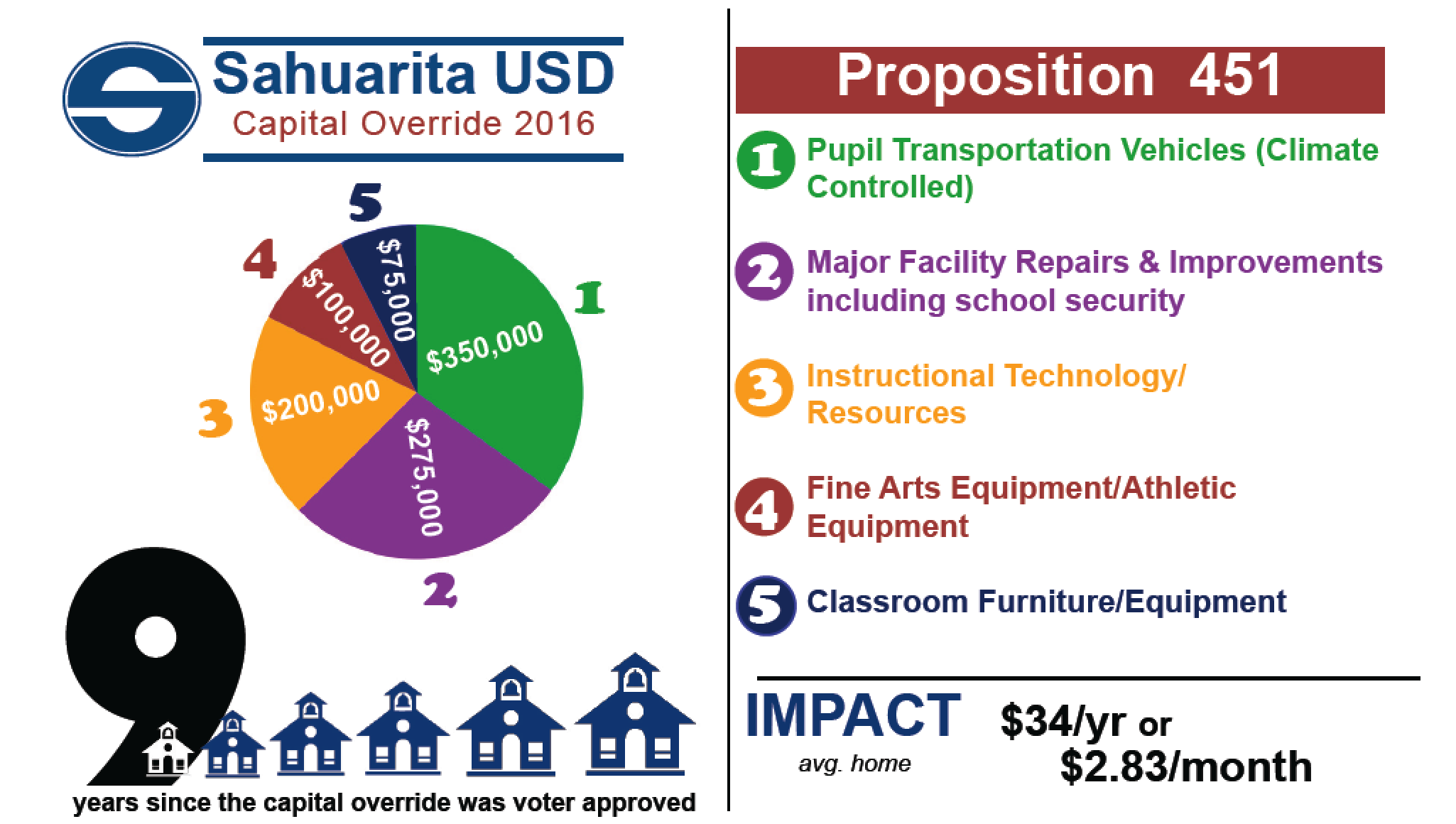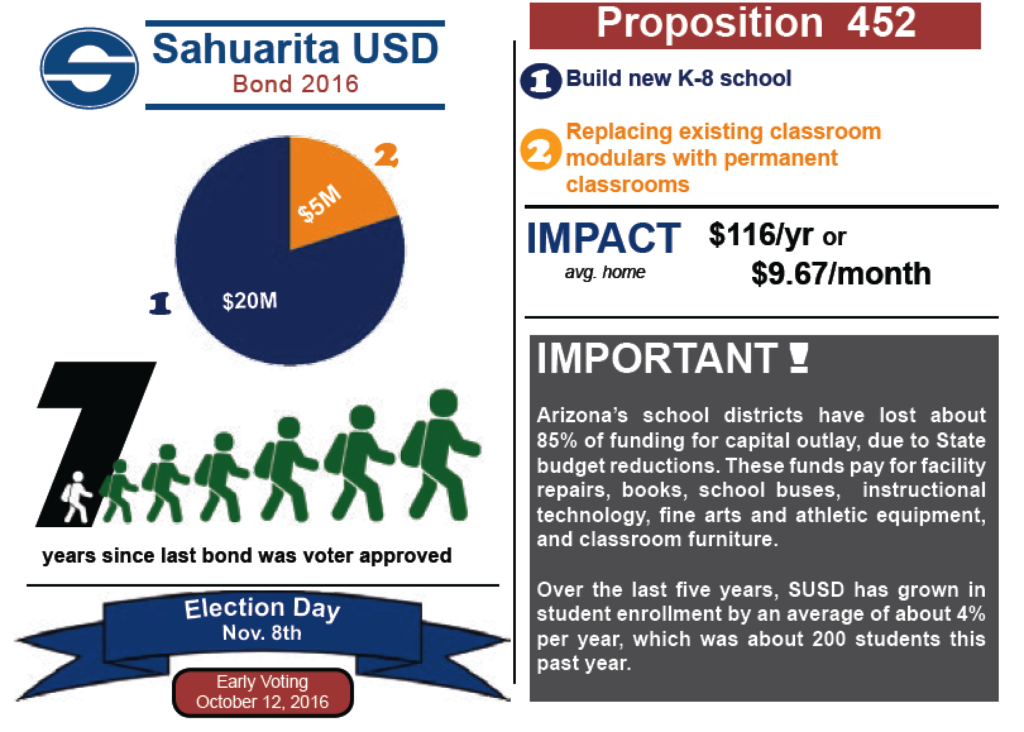2016 Bond/ Override
Letter to the Community
THE 2016 Override
Proposition 451
The passage of Proposition 451, a Capital Override, would provide the district $1 million each year for the next 7 years.
THE 2016 Bond
Proposition 452
The passage of Proposition 452 would result in a $25 million bond for a new K-8 school as well as new classrooms on the main campus (by replacing old portable buildings on the main campus.)
COMMUNITY SURVEY
See the Summary of the May 2016 Community Survey to determine the level of public support for proposed elements of a 2015 bond initiative for the district.
Bond Publications
2016 Bond/Override Presentation
Frequently Asked Questions
Much like a home mortgage, a bond is a contract to borrow money and repay it with interest. Bonds allow the district to finance new school construction, renovations and additions, equipment, technology infrastructure and the purchase of land.
Overrides are used to provide additional funding to support what happens inside school classrooms (teaching, learning and operations). A Maintenance and Operations override (M&O) supports things such as teacher salaries, benefits, supplies and general operations. A capital override funds equipment, furniture, technology, vehicles, etc.
Capital improvements are large expenditures expected to have long-term use, such as new schools, renovations, furniture, equipment, school buses, technology infrastructure and school sites.
Arizona’s school districts have lost about 85% of funding for capital outlay, due to State budget reductions. These funds pay for facility repairs, books, school buses, instructional technology, fine arts and athletic equipment, and classroom furniture. Over the last five years, SUSD has grown in student enrollment by an average of about 4% per year, which was about 200 students this past year.
In order to proactively plan for future needs, SUSD is constantly reviewing sources of data, including student enrollment growth trends, capacity of school facilities, financial data, and emerging development directions. The data clearly indicates ongoing, significant growth patterns and diminishing school capacities to accommodate the growth. Stakeholder outreach efforts, including community conversations and surveys, were implemented to communicate about the issues, and gather feedback about possible solutions. After considering the data and possible solutions, a recommendation was made to the SUSD Governing Board.
The duration of property tax used to repay the bond would be 20 years.
As a growing district, in a growing community, it is foreseeable that new schools will continue to be part of our future. This particular building is anticipated to relieve the current and emerging pressure in the K-8 levels for the next five (5) years. These trends are constantly being monitored in order to support proactive planning efforts.
Good schools correlate with higher property values. By investing in the public schools in Sahuarita, you are investing in the long-term value of your home.
Class sizes at the K-8 grade level will continue to grow. Schools will exceed maximum capacity, and non-instructional spaces will have to be used as classroom space.
The last voter-approved bond was in 2009. All targeted bond objectives were completed, on time, and at or below budget. A bond proposal appeared on the November 2015 ballot, but was narrowly defeated. The last voter-approved capital override was in 2007. The capital override was not renewed on the 2014 election ballot.
Information is available about the school needs, objectives of the bond, costs, and overall implications through the school district. There is also an advocacy organization, called Yes For Sahuarita Schools, which welcomes community involvement in overt efforts to pass the bond and override.
Bond funds may not be used for operating expenses like teacher staffing or raising teacher salaries. Basically, they are designed to fund bricks and mortar type of projects and associated equipment.
Bond dollars may be used to buy some capital assets with a shorter lifespan. Although the regulations require such items to be paid within a shorter, five(5) year time span, community feedback suggests a preference for purchasing capital items with a shorter lifespan via a current year capital override, hence the determination to pursue a capital override.
No bonds authorized to be issued by an election held after November 24, 2009, may be issued more than ten years after the date of the election.(15-1021). However, given the urgency of the targeted objectives, it is anticipated that these bonds will be sold within two years, to support the opening of a new school by Fall 2018.
The bid process is closely governed by specific procurement rules and regulations. The District could go out in a traditional “hard bid” process. More common in today’s school construction environment is the Construction Management At Risk (CMAR). In CMAR, the District will go out in a Request For Qualifications (RFQ), where different contractors present their credentials for such a large project. A committee of qualified professional members will review, evaluate, and make a recommendation to the Superintendent for final approval by the Governing Board. The District then works with its architect to develop the project and determine a guaranteed maximum price. This collaborative process supports a cohesive and shared commitment to delivering the final product on time, under the GMP, and to a high standard.
Interest rates in the current market are still favorably low. Barring any major fluctuations in the coming months, it is anticipated that the lending rate will be in line with current trends, although market conditions are subject to change.
Yes, the bonding capacity of the district is statutorily determined to be a given percentage of the total assessed valuation of the cumulative properties that make up the district. That amount is 10%. This bond would put the district at 98.9% of its capacity.
The Primary tax is used to fund Maintenance and Operation budget/District Additional Assistance (DAA). In addition, a Secondary tax is utilized to fund Class B Bond interest and Redemption and a Secondary tax funds Maintenance and Operations Overrides.
In FY 15-16 our bond rate was $1.39. In FY 16-17 it was estimated that our bond rate would have been $1.58, but the District was able to buy down the rate to $1.49.
The District is working with the Rancho Sahuarita Company to secure a generous land donation in the path of projected growth. The proposed site is about 1 mile south of Sahuarita Rd., along the line of Rancho Sahuarita Blvd.
The new K-8 school will be located on a parcel of land one mile south of Sahuarita Rd. on the new extension of Rancho Sahuarita Blvd.
It is anticipated that the bonds will be sold shortly after the new calendar year in 2017, and formal design, planning, and construction phases will commence in sequence after that. The target opening date for the new K-8 school is Fall 2018.
The objective of the new school is to accommodate growth and support appropriate class sizes at all schools. If the school bond is approved, a comprehensive process will ensue, with a leadership committee of multiple stakeholders, and parent engagement, to establish boundary realignment criteria, and begin pursuing the most sound, efficient, and logical attendance areas.
Approximately 800 students.
The new school will incorporate K-8 students of families from the new development of houses that will be built near the new school. In addition, it will be used to alleviate overcrowding at Sahuarita Primary, Sahuarita Intermediate, and Sahuarita Middle School. The planning process is focused on advancing equitable program and operating objectives at all schools. This includes goals about class sizes, instructional programs, facility amenities, and educational technology. The boundary realignment process will address criteria, input, communication, and procedural norms for determining student assignments and open enrollment options, as allowable.
A limited percentage of the bond may be used for furniture and equipment. For example, some of the millwork and cabinets may be paid from the bond. However, we are counting on the DAA Override to generate dollars to support the purchase of necessary furniture and equipment, such as desks and chairs.
The current capital outlay formula provides SUSD with $2,700,000 in allocation. In this year’s budget, about $2,300,000 of that was cut through State reductions. If an additional $1,000,000 is added to the difference (about $400,000), the deficit is offset to a degree thus lessening the reduction.
Preliminary analysis suggests that the District can build a K-8 school for the $20,000,000. The District has strong collaborative relationships with both private and public sector partners, and we are certainly open to exploring further cooperative and mutually beneficial endeavors, such as the shared arrangement at Anza Trail K-8 with the Town of Sahuarita Parks and Recreation Department.










